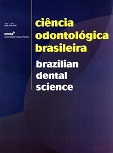Alterações do plano oclusal decorrentes do tratamento ortopédico com o Bionator de Balters em pacientes com má-oclusão classe II, divisão 1a
DOI:
https://doi.org/10.14295/bds.2009.v12i1.257Abstract
Objetivo: Esse estudo avaliou alterações no plano oclusal decorrentes do tratamento de pacientes com má oclusão de Classe II e retrognatismo mandribular por meio do bionator de Balters. Material e Método: a amostra utilizada neste estudo retrospectivo foi coletada no acervo de documentação ortodôntica do curso de especialização da Universidade Paulista – UNIP, e consta de 60 teleradiografias (sendo 30 tomadas realizadas antes do tratamento e 30 após) em normalateral de 30 indivíduos portadores de má-oclusão Classe II, divisão 1a, brasileiros, de ambos os sexos, com idade média de 9 anos e 2 meses ao iniciarem o tratamento. As avaliações cefalométricas foram realizadas em dois tempos, T1 (antes do tratamento) e T2 (após tratamento ortopédico). Foram avaliados os ângulos Ba-Na/plano palatino, Se-Na/plano palatino e plano palatino/plano oclusal funcional. Resultado: Apenas a variável plano palatino/plano oclusal apresentou diferença estatiscamente siginificante quando comparadas antes e após o tratamento (p<0,05). Conclusão:Os resultados obtidos demonstraram uma estabilidade significativa do plano palatino em relação aos planos Ba-Na e Se-Na e uma rotação no sentido anti-horário do plano oclusal funcional, estatisticamente significante em relação ao plano palatino.
Downloads
Downloads
Published
How to Cite
Issue
Section
License
Brazilian Dental Science uses the Creative Commons (CC-BY 4.0) license, thus preserving the integrity of articles in an open access environment. The journal allows the author to retain publishing rights without restrictions.
=================




























